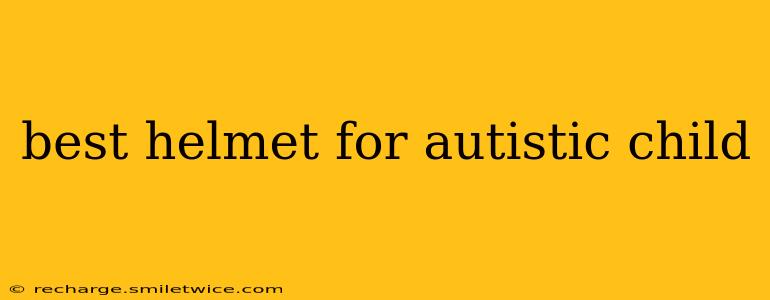Finding the right helmet for a child, especially one with autism, requires careful consideration of several factors beyond just safety. While all children need helmets that fit properly and offer adequate protection, autistic children may have sensory sensitivities, specific behavioral patterns, and individual preferences that influence helmet selection. This guide aims to help parents and caregivers navigate this process, ensuring both safety and comfort.
What Makes a Helmet Suitable for an Autistic Child?
The ideal helmet for an autistic child balances safety features with considerations for sensory processing differences and individual needs. This means looking beyond the standard features and considering:
-
Material and Texture: Some autistic children are highly sensitive to textures. Opt for helmets made from smooth, soft materials that avoid rough seams or irritating fabrics. Consider helmets with padded interiors. A hypoallergenic liner is also a wise choice to minimize skin irritation.
-
Weight and Fit: A helmet that's too heavy or ill-fitting can be incredibly uncomfortable and lead to frustration or resistance. Prioritize lightweight helmets with adjustable straps and sizing systems to ensure a precise and comfortable fit.
-
Appearance and Design: Many autistic children have strong preferences for colors, patterns, and designs. If possible, involve your child in the selection process to choose a helmet they find appealing. This can significantly increase the likelihood of them wearing it willingly.
-
Sensory Considerations: Certain helmets may have features like bright colors, reflective materials, or unusual textures that could be overstimulating for a child with sensory sensitivities. Opt for simpler, less visually stimulating designs. Consider helmets with muted colors and minimal embellishments.
How to Choose the Right Size and Fit?
Proper fit is paramount for safety and comfort. A helmet that's too loose won't provide adequate protection, while one that's too tight will be uncomfortable and possibly cause headaches. Follow these guidelines:
-
Measure Your Child's Head: Use a soft measuring tape to measure the circumference of your child's head just above the eyebrows.
-
Check the Helmet's Sizing Chart: Refer to the manufacturer's sizing chart to find the appropriate helmet size based on your child's head measurement.
-
Try it On: Allow your child to wear the helmet for a few minutes. Make sure it sits level on their head, about an inch above their eyebrows. The straps should be snug but not too tight. The helmet should not rock or move around when you gently try to shift it.
What are the Safety Standards for Children's Helmets?
Always prioritize helmets that meet or exceed relevant safety standards. Look for certifications from organizations like the Snell Memorial Foundation or the CPSC (Consumer Product Safety Commission). These certifications indicate that the helmet has undergone rigorous testing to ensure it meets safety requirements.
What if My Child Refuses to Wear a Helmet?
This is a common challenge, especially with autistic children. Here are some strategies:
-
Positive Reinforcement: Reward your child for wearing the helmet, even for short periods.
-
Gradual Exposure: Gradually increase the time your child wears the helmet. Start with short intervals and gradually extend them.
-
Make it Fun: Incorporate play or activities while wearing the helmet.
-
Sensory Integration Therapy: If your child has severe sensory sensitivities, consult an occupational therapist specializing in sensory integration therapy. They can offer strategies to help your child adapt to wearing a helmet.
Are There Specific Helmets Designed for Autistic Children?
Currently, there aren't helmets specifically marketed for autistic children. However, by carefully considering the factors outlined above, you can choose a helmet that best suits your child's individual needs and preferences.
What other safety gear should I consider?
Beyond the helmet, ensure your child has age-appropriate protective gear for the activity they are participating in. This might include knee pads, elbow pads, and other safety equipment that complements the helmet and enhances overall protection.
By carefully considering safety standards, fit, sensory needs, and individual preferences, you can choose a helmet that protects your autistic child effectively while also promoting comfort and cooperation. Remember, open communication and patience are key to success. If you have any concerns, consult with your child's pediatrician or a specialist in autism spectrum disorder.
